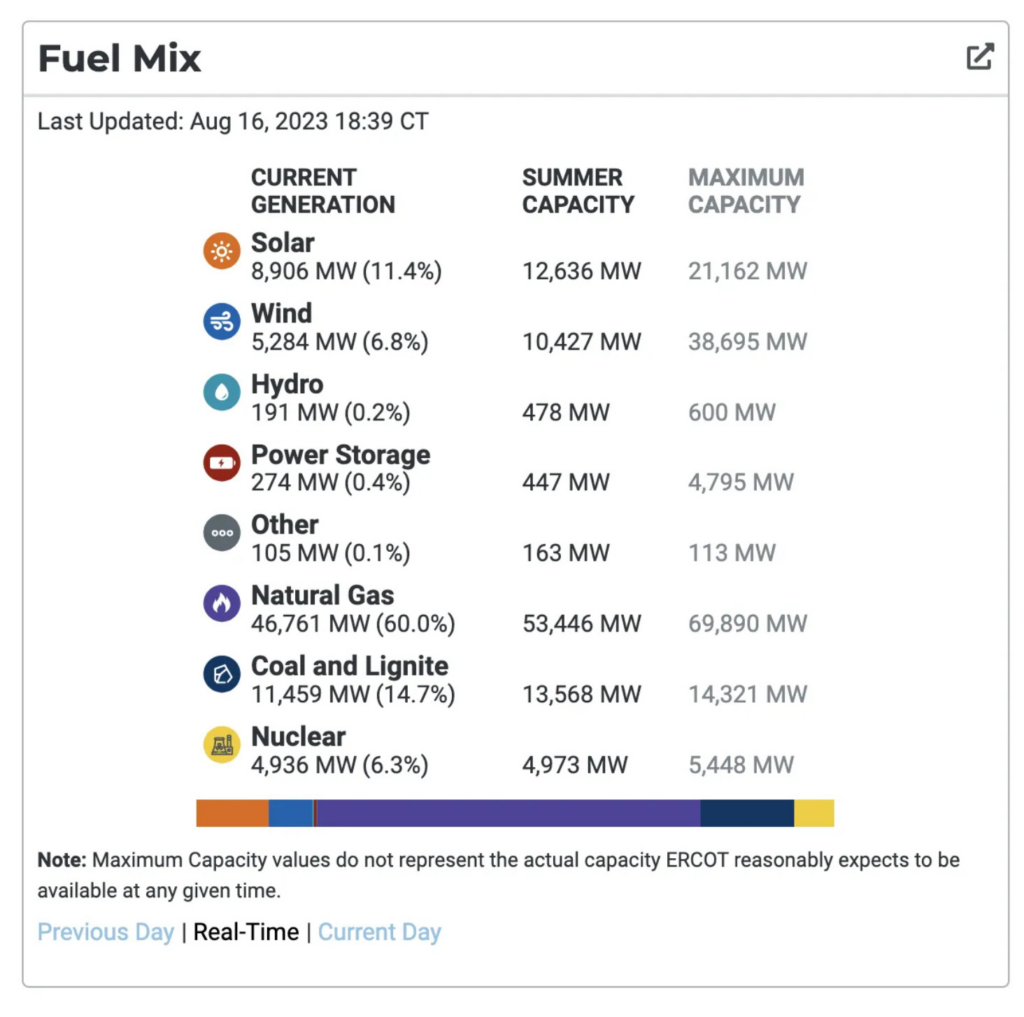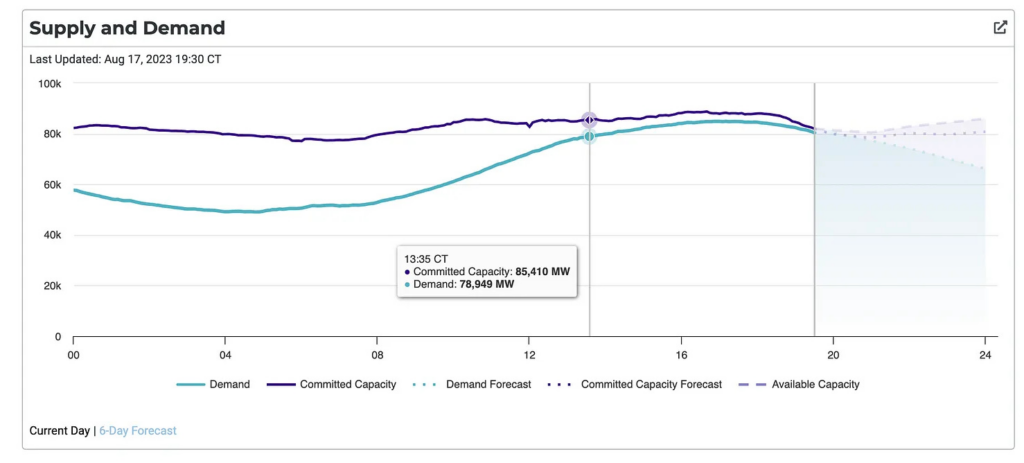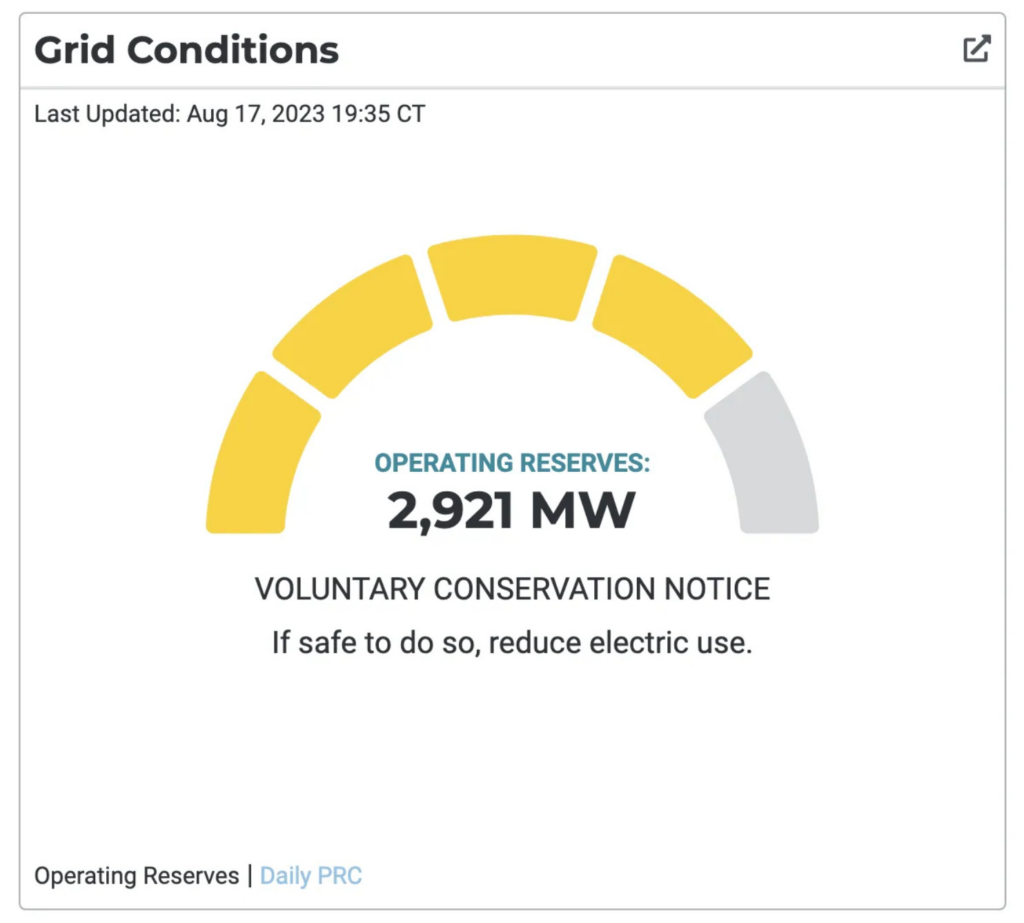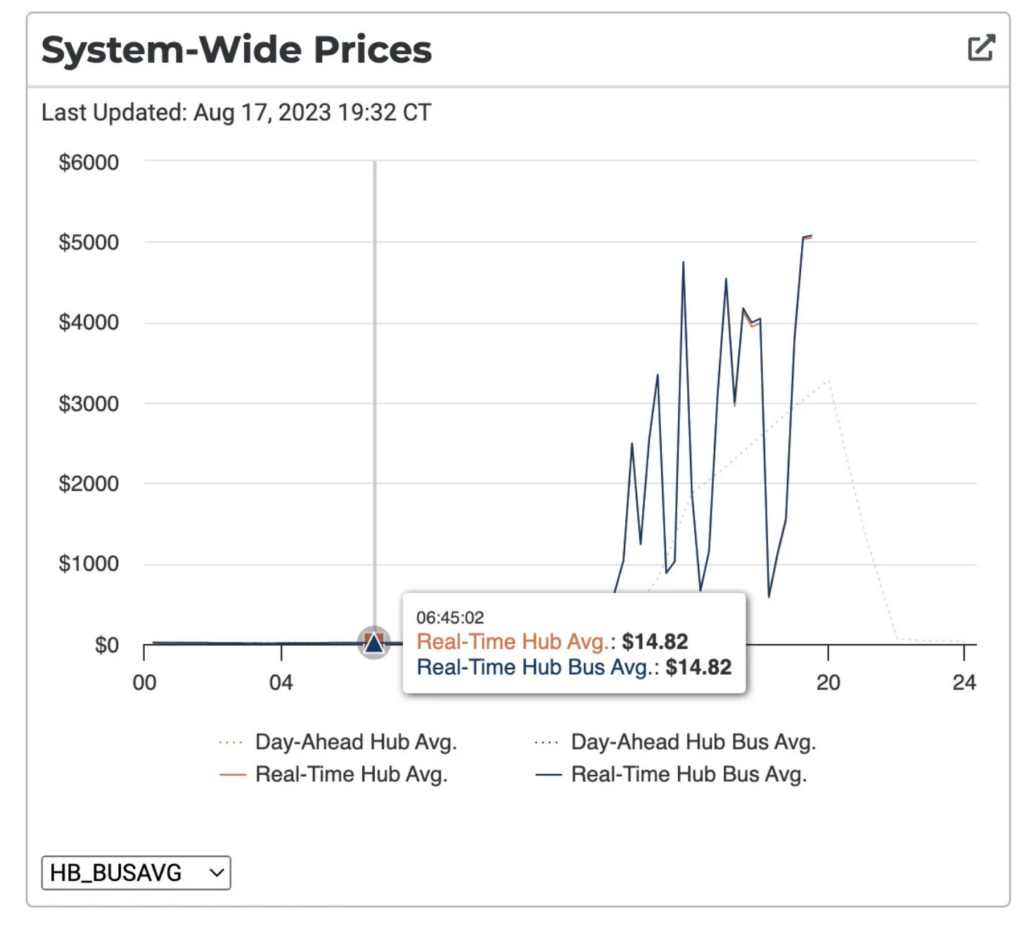Wind Output Plaguing Texas (ERCOT weathers on)
By Ed Ireland -- August 21, 2023“Failures of wind and solar during severe weather events are a problem, but a larger problem is that failures are not confined to severe winter storms. In fact, these failures occur on a daily and even hourly basis. During the summer months, wind tends to die down in the afternoons, causing large drops in wind-generated electricity. Later afternoon rain storms can reduce solar generation significantly.”
Texas is blessed with mineral and natural resources. Texas is the largest crude oil and natural gas producer in the US. It would be the world’s 4th largest producer if Texas were a country.
For reasons of politics and government intervention over a quarter-century, Texas is the largest wind power producer and second-largest solar producer in the U.S. and will likely surpass California, the leading solar power state, within a year.
We long have been told that wind and solar can replace coal, oil, and natural gas for power generation, but nothing could be farther from the truth. Wind and solar are dilute, intermittent sources that depend on the weather. If the wind is blowing and the sun is shining, they may work to some extent, but the weather changes constantly, and so does their ability to produce electricity.
An epic failure of wind and solar in Texas was during Winter Storm Uri in February 2021. While there were failures in all types of generation, including coal, nuclear, and natural gas, due to the sub-freezing and even sub-zero temperatures, wind turbine freeze-ups were a major problem for the ERCOT system. (Ruined margins for the reliables from wind/solar had a major negative effect too in setting up the failure, a separate story.)
Less than two years later, in December of 2022, wind and solar failed again during Winter Storm Elliot, but the State had learned some lessons from Uri and was prepared with sufficient natural gas, coal, and nuclear-generated electricity.
Failures of wind and solar during severe weather events are a problem, but a larger problem is that failures are not confined to severe winter storms. In fact, these failures occur on a daily and even hourly basis. During the summer months, wind tends to die down in the afternoons, causing large drops in wind-generated electricity. Later afternoon rain storms can reduce solar generation significantly.
Peak Demand, Unreliable Supply
The summer of 2023 has been a very hot one as a result of two weather overlapping events: El Nino and the eruption of the Hunga Tonga–Hunga Ha’apai volcano eruption, with El Nino bringing in hot air from the west and the HTHH forming a heat cap, resulting from the extremely large volume of water vapor accompanying the eruption.
The enhanced greenhouse effect? Not so much because the GHG ‘signal’ has a winter, night, high latitude character–not one of Texas summer afternoon. Abruptness (Spring was relatively normal) fits nature, not the human influence.
The resulting summer heat has stressed many power grids due to higher-than-normal cooling demand. The combination of these two weather events has produced very hot summer conditions in the US and other parts of the world and added another layer of stress to power grids.
In Texas, the higher-than-normal air conditioning loads coupled with its high installed capacity of wind and solar have been challenging for the load management on the ERCOT power grid for two reasons: (1) the wind tends to subside on hot afternoons, and (2) solar panels lose capacity due to the high temperatures. This leads to a double whammy for the Texas power grid of losing electric generating capacity from both wind and solar.
These losses are documented on the ERCOT “Dashboards” as shown below for Thursday, August 17, 2023:

Note that the Maximum Capacity for solar is 21,162 megawatts (MW), while its summer capacity is only 12,636 MW. The “Maximum Capacity” for wind is 38,695 MW, while its Summer Capacity is only 10,427 MW. The low summer capacity for wind is due to the fact that winds die down in hot afternoons, so wind turbines fail to produce anywhere near their capacities. Solar panels are less efficient in converting sunlight to electricity at warmer temperatures. Note that the solar panels in this example were performing near their “Summer Capacity” earlier that day on August 16, 2023, but this screenshot was taken at 8:30 PM when the sun was setting, and the temperature had declined.
With Coal and Nuclear operating at their maximum levels (coal is actually producing over its Summer Capacity), the power grid is dependent on natural gas to keep the lights on and the air conditioning running, and it did its job, producing 60% of the power being produced on the grid.

Nevertheless, the ERCOT power grid dropped below its acceptable minimum level of 3 MW, as shown in the graphic below, which is an automatic voluntary conservation notice.

This low level of operating reserves is reflected in the “System-wide Prices” graph shown below, which shows that spot prices for natural gas reached $5,000 per megawatt for a few minutes, which is the maximum price allowed on the ERCOT system.

Price spikes are a predictable consequences of faulty supply-side energy reliance.
Conclusion
Wind and solar are not reliable enough to maintain grid stability and therefore require dispatchable power sources such as coal, nuclear, and natural gas-powered generation to stabilize the grid. Until sufficient utility-scale battery storage is available, which is unlikely anytime soon due to the cost of current technologies, the ERCOT power grid and all others will require substantial natural gas generation capacity to maintain grid stability.
The Texas legislature understood this requirement and passed several bills with appropriate spending to keep the ERCOT power grid running with enough dispatchable power to maintain its reliability. ERCOT is doing a commendable job managing the Texas power grid this hot summer–even with the largest wind and second-largest solar portfolio in the US–thanks to Texas being the largest natural gas producer in the country.
——————
Ed Ireland, adjunct professor at TCU’s Neeley School of Business, received his B.S. from Midwestern State University and Ph.D. from Texas Tech University. His substack site is Thoughts About Energy and Economics.
The differences between “maximum capacity” and “summer capacity” shown in the ERCOT “Dashboard” above highlight the critical importance of long-duration storage in a fossil fuel free grid. Batteries are not now suitable for long-duration storage and might not ever be suitable, no less economic.
Thanks to Ed Ireland for this timely and insightful report on the status of the various energy sources for the Texas electricity grid system. It’s becoming more apparent that Wind and Solar is not is not the answer for reliable and less costly electricity. In fact, there is abundant evidence now showing that when ALL COST are considered wind and solar is more detrimental to the environment and expensive than fossil fuels.
Great article. Supplementing when you don’t have to for subsidies (if that is the case) was whose idea? Who signed off on that? Follow the money because somebody made a lot of money to push that bad idea on Texas at the cost of how many lives? Hopefully the right people will read this and rethink.
Time stamp is 1839 which is 639 PM, not 830 as listed in article. Peak solar generation at mid- day would have been more useful and representative.
This green insanity is sweeping the country. The cost is enormous.
Where I live I can count about 100 or so windmills from my porch plus two windmill blade bone yards They can not be recycled I personally saw how they froze up with ice during the first -7 degrees storm I was so glad to have a propane heater
Where does MSW to energy fit into this study?
At best batteries will be fitted out for a 4 hour demand curve, as basically an emergency only device. They really can’t afford them otherwise, nor can they manufacturer enough OF them really.
I get a kick out of the latest vapor dream, well let everyone own their own battery and they can supply to the grid when we need and it’ll PAY for their battery system!!! Not so fast. They will probably be using their own electricity first, THEN IF there is any left trickling it to the grid.
Either way it’s a hot mess and it is not going to get anywhere soon.
So called “Green Energy” is obviously as much of a scam as ” Electric Vehicles” and the climate hoax.
I knew wind was intermittent but I didn’t know besides clouds and night time that heat could reduce the efficiency of solar cells as well. I just read an article by the WEF (those reptilian a-holes that seek to rule over us “for our own good”) that claims billions of EVs are needed by 2050 to meet “emissions goals” and there isn’t enough lithium.
Well if there isn’t enough lithium for EVs with it being used for things like laptops and cellphones how could their possibly be enough for grid sized batteries? Not only that but what about the new machines needed to create grid momentum considering intermittent “green energy sources” don’t help with this. If Commiefornia can’t power its grid in the summer with the amount of “green energy” and “electric vehicles” they have now how will the rest of us fair when there are billions of “electric vehicles” on the road and many grids have ramped up “green energy” production? Not only that but the same “big brain” energy trying to force us all to “electric vehicles” and “green energy” also wants to blot out the sun, negatively impacting solar production. I don’t understand how anyone believes this nonsense about needing to reach “0 emissions” when any investigation or critical thinking proves it simply isn’t possible. ICE vehicles are superior to “electric vehicles” in every way except acceleration and braking.
You can fill up the tank on an ICE engine much faster than you can charge an “electric vehicle” and go further with a tank of gas than a full charge. Not only that but if you run out of gas you just need someone to get a full gas can and put it in the tank and you are good to go. An “electric vehicle” needs a tow and possibly a service station. With charging stations being crowded, unreliable and few and far between even on the West Coast were a lot of folks drink the koolaid I fail to see how there can be enough in other parts of country were people are much more practical. Not only that but local neighborhood grids could not support the amount of strain having every house having a charging station would put on them without a serious overhaul and “electric vehicles” have ranges cut severely short by temperature fluctuations and a heavy cargo load. You also have to worry about the battery catching fire requiring specialized equipment to put out in cases were an ICE vehicle isn’t a fire risk.
Why are we not exploring the limitless supplies of hydrogen for our energy needs as much as we are stupid batteries, for which we have not enough rare-earth materials to make them, while we are ripping up the earth using child labor to get what there are, no recycling plan, killing birds, polluting the Earth massively by the pursuit of this waste of time and effort and resources, etc. Hydrogen comes from splitting the O2 out of water, which leaves oxygen as the only exhaust. How about we devote our tax dollars to figuring that one out on small and large scales. What am I missing here? Globalist elites will not profit enough?
Because your program is energy statism, not what consumers would choose in a free market.
NOTE: I hate the WEF and what the Democrats are doing to this country. Truly, I do. I also drive a Ford 250 diesel… But I’m still pro-renewables. There are real issues with intermittentency but they are solvable. Long distance HVDC (High Voltage DC) lines, which can three times the distance as HVAC lines can share the wind in the Dakotas… the sun in the southwest… the hyrdo from the north with the whole country. EVs with bi-directional charging can step in to cover sags in the grid. “Overbuilding” cheap utility-scale solar can help with the intermittency issue, which is WAY cheaper than current battery technologies. Distributed solar generation across the country can help insulate the grid from localized weather impacts. Wind and solar are complementary in that when one is ramping up the other is slowing down.
Renewables like wind and solar also help bring power online with ZERO ongoing water usage. That’s a big deal across the globe, as emerging economies continue to put pressure on fresh water resources for both food production and energy production.
All that said, we’re not at a technological point where we can (practically) do it all with renewables and we’ll need good old fashion, coal, NG and nuclear to back stop the grid for at least the next decade… nuclear for possibly two or three more decades. But we can (and should) responsibly advance the penetration of renewables into the grid. Clean skies… energy independence… decreasing dollars supporting OPEC and the regimes that hate us like Russia and Venezuela. If we do it thoughtfully and deliberately there’s immense upside. And if Republicans can cast this vision in a measured reasonable way, as opposed to the sky-is-falling, don’t-waste-a-crisis Democrats the world will be a better place for it.
Your program is based on government intervention and either taxpayer dollars or inflation finance. Your recommendations sound like an energy planner, the I-know-better-than-you “fatal conceit’ (as FA Hayek would put it).
The grid needs a free market with an end to wind/solar subsidies and, frankly, a moratorium on wind and solar that requires government intervention to enter the market.
Hydrogen’s time is coming… we initially passed on Hydrogen and stuck with batteries for two reasons: 1) every single family home has a electric charging station in its garage for battery-based EVs 2) the round trip efficiency of hydrogen just 15 years ago was horrible… like 50%. Round trip efficiencies are improving vastly. (I recently heard 80% efficiency.) If they can keep improving the round trip efficiency then I could see Hydrogen having a meaningful role going forward. But we still have to solve for the infrastructure variable.
And for those of you who would say the grid can’t support all the EV charging… that’s just not true. It can – TODAY! The grid can’t support every EV charging from zero to 100 percent every night. But it doesn’t have to. How many of us use a full tank of gas (or in my case, diesel) every day? 80 percent of us commute about 40 miles a day. So if 4 out of 5 cars were EVs and every house had 5 cars… that would require about 60 kWhs of energy each night. If there’s only 10 hours to charge, that’s 6 kWs… or about 25 amps continuously. Even the smallest homes have 100 amp panels and could run an AC unit (5000 watts or about 20 amp) and a bunch of other house loads (another 20 amps) and still sufficiently charge 4 EVs. Most homes have 200 amp panels and large homes typically have 400 amp panels. And most homes don’t have four EVs either, but the point is they could.
At the end of the day, we have to decide if we want to continue to participate in economies that are largely controlled by several bad actors that hate America…. or if we want to try and build new economies that “democratize” energy production for all (not just nation states, but individuals)… conserve fresh water… don’t pollute the air we breath and don’t create WMDs as byproducts. I know there’s a lot of manipulation around “green” energy. I hate it, too… but I hate it because it creates a divide that doesn’t need to exist. Conservatives need to articulate a better way forward that everyone can support.
Can we let consumers in the US market decide and keep politicians out of it? Can your technology work w/o government? Energy freedom or energy statism?
I have seen Wind Farms in California in the Altamont Pass for decades. They have many failed Wind Generators in the Altamont Pass and many not running. Solar Farms in California have also had the same thing happen: they get placed and work for several years and then fail and get ripped out.
Only Coal, Natural Gas, and Nuclear Plants work for long periods of time. Plus they work 24/7 and feed from one central point. The issue that are critical for the USA and electric companies is the electric grid, and making the grid more up to date and fix problems.